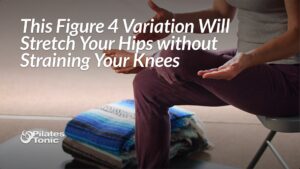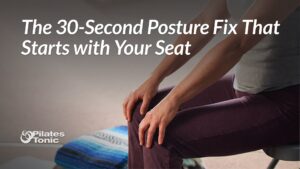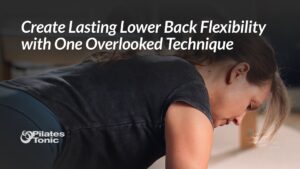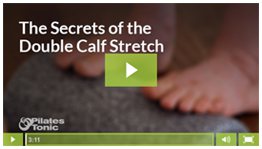Today's video is all about stretching your quads and this stretch is one of the best I've ever found. But, in order to get the most out of it, it helps to understand just a bit of anatomy and how your quads become tight in the first place.
Why Your Quads are Chronically Tight
Chronic tightness in the quadriceps is an epidemic in our culture. When the quads get too tight and/or short, it affects the blood flow in your legs, limits your ability to straighten your legs and changes how you walk, stand and sit.
The quadriceps group consists of four muscles on the front of each thigh. Their main job is to extend, or straighten, your knee.
One of your quadriceps, the rectus femoris, also happens to be a hip flexor.
Your rectus femoris attaches to the front of your pelvic bones just above your hip sockets and the other end attaches just below your knee.
Rectus femoris is a long muscle that crosses two joints, and when it gets tight and short it hurts your ability to walk, stand, and especially to practice Pilates!
In fact, chronically tight and turned on quads can make Pilates downright unpleasant!
Unbalanced Weight
There are a number of reasons the quad muscles become tight and stay that way. Standing with your weight too far forward toward your toes, or too far back in your heels causes your quads to turn on and stay on at a low level to keep you from falling over forward or backward.
Overworking While Walking
Your quads can also stay chronically tight from overworking when you walk. We’ve talked before about short and tight hip flexors stopping your leg from going behind your body when you walk. And ideally how, when walking, you want your leg to reach behind your body so that your foot can push off from the ground and propel you forward.
When your leg isn’t able to go behind you, your glutes can’t activate properly to assist in propelling you forward. This creates a situation where your quads and hip flexors work overtime to pull you forward instead. Walking this way requires much more energy and is not efficient at all.
Gripping Your Kneecaps
I recently discovered that I have a habit of unconsciously gripping my kneecaps with my quads, even when I’m lying down. (I have a video coming up in the near future showing what to do if you're a kneecap gripper too, but in the meantime this quad stretch is a great place to start.) This type of unconscious kneecap gripping also keeps the quads tight.
This exercise comes from Katy Bowman’s Restorative Exercise™ repertoire and I think you are going to love it.
Form Point: Stretching the quadriceps can be tricky because it’s very easy to subtly shift into your low back or pelvis to escape the stretch without even realizing it. With this exercise, there’s no escape!
Give the Quad Stretch a try and let me know how it goes in the comments below.
See you in the studio,
Sydney
P.S. – If you don't have a yoga strap at home you can also use a belt to assist you with this exercise.





10 Responses
Very helpful to have the pubic bone landmark to ensure proper form! I am referring my massage clients to your videos. I hope they are signing up! Thank you.
Thanks so much for the referrals Ann! 🙂
I am having pain in my hamstrings and the upper thigh, quads. How do I help my hamstrings?
Hi Cheryl, here’s two different exercises you might find helpful, the Flamingo Stretch and the Double Calf Stretch. Thanks for your question!
Hi Sydney
Do you know if anything that will help my lengthend hamstrings . I don’t exactly know how they got like this but I can tell because I am walking differently and I don’t want to over stretch them further.
Hi Tanesha, It’s hard to give a specific suggestion without seeing you and hearing more about what you are experiencing. Thanks for your question!
Hi I’m just wondering what is going on when a person has to abduct their leg to grab their leg but then can line up their knee again once they have a hold of their foot?
Hi Sarah, Thanks for your question! My theory is there’s too much tension on the front of the thigh for the hamstrings to overcome without cramping to get into the position. Abducting the leg shortens the distance required to grab the ankle. Once the ankle (or foot) is held by the hand the hamstrings can relax making it easier to bring the leg back in line.
Hi Sydney, what does it mean if this stretch causing intense pain in the knee? Especially as you release the strap. Is this an indication that there is something else preventing the quads from stretching properly?
Hi Kyr, It’s possible easing up and not bending your knee as far could help. That said, I would discontinue this exercise if you feel intense pain in your knee and seek a medical opinion. Thanks for your question!